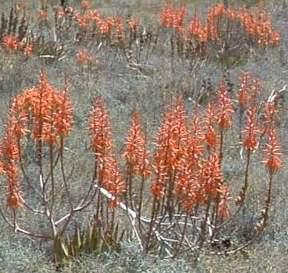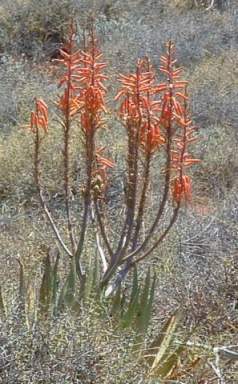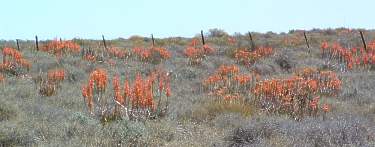Aloe falcata
Aloe falcata Baker
Family: Asphodelaceae
Common names: Vanrhynsdorp aloe
Introduction
Aloe falcata is a summer-flowering aloe that is becoming a popular subject for dry gardens, especially in the Western Cape where water resources are scarce.

Description
Description
Aloe falcata is a low-growing aloe that forms a dense, compact clump, with the rosette of leaves often pointing outwards. The plants almost appear if they are lying slightly on their sides. Aloe falcata often resembles A. claviflora the jakkalstertaalwyn (jackal's tail aloe) from the Northern Cape and Central Karoo.

The leaves are relatively smooth, but the margins of the leaves have small, sharp thorns on them. The leaves have an almost bluish hue. The inflorescence, is branched-sometimes up to a dozen flower spikes can be seen emerging from the crown. The flower spikes are erect in their growth form. Flower colour ranges from dull, brick-red to pinky red. Pure yellow flowers are very rarely seen.
What makes this particular aloe interesting is the fact that it flowers during the hottest and driest part of the year-December and January.
The seeds are brown, flat, and surrounded by a thin, transparent membrane which assists with wind dispersal. The seeds are blown some distance from the parent plant.
Distribution and habitat
Distribution description
Aloe falcata has a relatively small distribution in the winter rainfall area of South Africa. It occurs in the northwestern section of the Western Cape just north of Klawer, and proceeds north to the Richtersveld in the Northern Cape. It is not known in southern Namibia. It is used to extreme heat (above 40°C), but it can survive in relatively low temperatures (-3°C).
The plant appears to have a wide tolerance of habitats, and is found in red Kalahari sands, on dry stony slopes or sandy flats.
Derivation of name and historical aspects
History
According to Reynolds (1950) Aloe falcata was described by John Gilbert Baker in 1880 from dried specimens collected by Zeyher (collection number 1678). It was not mentioned in the report of Simon van der Stel's Expedition to Namaqualand (1685-1686) even though the party would have surely have passed nearby large colonies of these plants on the return trip in the December - when the plant is in full flower, but is mentioned by James Backhouse who passed that way in 1839.
The specific ephithet falcata refers to the sickle shape of the leaves.
Ecology
Ecology
Pollination is done mainly by bees. It is possible that some evening moths could attribute to the pollinate this species.
The seeds are often blown under karoo-like shrubs. As in many succulents, life begins under the protection of a nurse plant which protects the young plant from the sun's strong rays. (A nurse plant is a shrub under which the young plant germinates & grows, protected by its leaves and branches.) With time they eventually outgrow their nurse.
Uses
Use
None are really known. It is a hardy survivor in a water-wise garden.

Growing Aloe falcata
Grow
This is done mainly from seed. It is however, possible to grow this plant by dividing. This involves splitting-up large plants that have several heads. Cut the plants from each other with a very sharp, clean knife. The severed ends can be dusted with flowers of sulphur to ensure no fungal spores rot the plant at a later stage. Dry the newly severed plants out for at least two weeks before replanting.
Seeds are produced in late February and in early March of each year (southern hemisphere). The seed capsules tend to go a pale green when they are ready for harvesting, and must be semi-dry and beginning to split open before seed is collected.
Use sandy loam with a small amount of very well-rotted, sieved compost. The seeds should be sown no deeper than 0.5 cm. Do not crowd too many seeds into a seed pan, this can lead to damping off when they start germinating. The sowing medium must be well drained. Do not over-water. Too much water at a time when the seeds are germinating will ROT them. Water four times a week under warm conditions, 28°C or above. During the winter months only water once every two weeks. Move to a sunny location for the initial germination, especially during the cold winter months.
Sow the seeds in April or May (southern hemisphere). By April of the following year the plants should be strong enough to be planted into a small, 9 cm plastic pots. Once again using a well-drained potting medium.
Aloe falcata once established will grow quickly. These plants respond well to organic foodstuffs, but should not be over watered.
References
- Reynolds, G.W. 1950. The aloes of South Africa. Cape Times, Parow, South Africa.
- Smith, G. & Van Wyk, B-E. 1996. Guide to aloes of South Africa. Briza Publications, Pretoria.
Credits
Ian Oliver
Karoo Desert National Botanical Gardens
July 2006
Plant Attributes:
Plant Type: Succulent
SA Distribution: Northern Cape, Western Cape
Soil type: Sandy, Loam
Flowering season: Early Summer, Late Summer
PH: Neutral
Flower colour: Yellow, Orange
Aspect: Full Sun
Gardening skill: Easy
Special Features:
Horticultural zones











Rate this article
Article well written and informative
Rate this plant
Is this an interesting plant?
Login to add your Comment
Back to topNot registered yet? Click here to register.